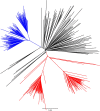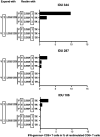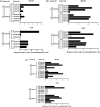Differential escape of HCV from CD8+ T cell selection pressure between China and Germany depends on the presenting HLA class I molecule
- PMID: 30260541
- PMCID: PMC7379502
- DOI: 10.1111/jvh.13011
Differential escape of HCV from CD8+ T cell selection pressure between China and Germany depends on the presenting HLA class I molecule
Abstract
Adaptation of hepatitis C virus (HCV) to CD8+ T cell selection pressure is well described; however, it is unclear if HCV differentially adapts in different populations. Here, we studied HLA class I-associated viral sequence polymorphisms in HCV 1b isolates in a Chinese population and compared viral substitution patterns between Chinese and German populations. We identified three HLA class I-restricted epitopes in HCV NS3 with statistical support for selection pressure and found evidence for differential escape pathways between isolates from China and Germany depending on the HLA class I molecule. The substitution patterns particularly differed in the epitope VTLTHPITK1635-1643 , which was presented by HLA-A*03 as well as HLA-A*11, two alleles with highly different frequencies in the two populations. In Germany, a substitution in position seven of the epitope was the most frequent substitution in the presence of HLA-A*03, functionally associated with immune escape and nearly absent in Chinese isolates. In contrast, the most frequent substitution in China was located at position two of the epitope and became the predominant consensus residue. Moreover, substitutions in position one of the epitope were significantly enriched in HLA-A*11-positive individuals in China and associated with different patterns of CD8+ T cell reactivity. Our study confirms the differential escape pathways selected by HCV that depended on different HLA class I alleles in Chinese and German populations, indicating that HCV differentially adapts to distinct HLA class I alleles in these populations. This result has important implications for vaccine design against highly variable and globally distributed pathogens, which may require matching antigen sequences to geographic regions for T cell-based vaccine strategies.
© 2018 The Authors. Journal of Viral Hepatitis Published by John Wiley & Sons Ltd.
Conflict of interest statement
The authors declare there is no conflict of interest regarding the publication of this paper.
Figures





Similar articles
-
Distinct Escape Pathway by Hepatitis C Virus Genotype 1a from a Dominant CD8+ T Cell Response by Selection of Altered Epitope Processing.J Virol. 2015 Oct 7;90(1):33-42. doi: 10.1128/JVI.01993-15. Print 2016 Jan 1. J Virol. 2015. PMID: 26446603 Free PMC article.
-
Genetic variability of hepatitis C virus non-structural protein 3 and virus-specific CD8+ response in patients with chronic hepatitis C.J Med Virol. 2004 Apr;72(4):575-85. doi: 10.1002/jmv.20036. J Med Virol. 2004. PMID: 14981760
-
Escape from a dominant HLA-B*15-restricted CD8+ T cell response against hepatitis C virus requires compensatory mutations outside the epitope.J Virol. 2012 Jan;86(2):991-1000. doi: 10.1128/JVI.05603-11. Epub 2011 Nov 9. J Virol. 2012. PMID: 22072759 Free PMC article.
-
Mutational escape from CD8+ T cell immunity: HCV evolution, from chimpanzees to man.J Exp Med. 2005 Jun 6;201(11):1709-14. doi: 10.1084/jem.20050808. J Exp Med. 2005. PMID: 15939787 Free PMC article. Review.
-
CD8+ T-Cell Responses in Hepatitis B and C: The (HLA-) A, B, and C of Hepatitis B and C.Dig Dis. 2016;34(4):396-409. doi: 10.1159/000444555. Epub 2016 May 11. Dig Dis. 2016. PMID: 27170395 Review.
Cited by
-
INeo-Epp: A Novel T-Cell HLA Class-I Immunogenicity or Neoantigenic Epitope Prediction Method Based on Sequence-Related Amino Acid Features.Biomed Res Int. 2020 Jun 15;2020:5798356. doi: 10.1155/2020/5798356. eCollection 2020. Biomed Res Int. 2020. PMID: 32626747 Free PMC article.
-
Immune escape pathways from the HBV core18-27 CD8 T cell response are driven by individual HLA class I alleles.Front Immunol. 2022 Nov 10;13:1045498. doi: 10.3389/fimmu.2022.1045498. eCollection 2022. Front Immunol. 2022. PMID: 36439181 Free PMC article.
References
-
- WHO . Hepatitis C. 2017. http://www.who.int/mediacentre/factsheets/fs164/en/. Accessed January 25, 2018.
-
- Asselah T, Boyer N, Saadoun D, Martinotpeignoux M, Marcellin P. Direct‐acting antivirals for the treatment of hepatitis C virus infection: optimizing current IFN‐free treatment and future perspectives. Liver Int. 2016;36(Suppl. 1):47‐57. - PubMed
-
- Grüner NH, Gerlach TJ, Jung M‐C, et al. Association of hepatitis C virus—specific CD8 + T cells with viral clearance in acute hepatitis C. J Infect Dis. 2000;181:1528‐1536. - PubMed
Publication types
MeSH terms
Substances
Associated data
- Actions
- Actions
- Actions
- Actions
- Actions
- Actions
LinkOut - more resources
Full Text Sources
Other Literature Sources
Molecular Biology Databases
Research Materials

